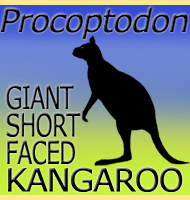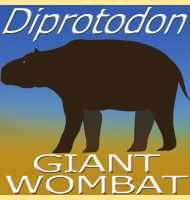


Ganguroo
Name: Ganguroo.
Phonetic: Gan-gu-ru.
Named By: B. N. Cooke - 1997.
Classification: Mammalia, Marsupialia,
Diprotodontia, Macropodiformes, Macropodidae, Bulungamayinae.
Species: G. bilamina
(type), G. robustiter.
Diet: Herbivore.
Size: Skull roughly 8 centimetres long.
Humerus about 5.7 centimetres long. Total body size uncertain
due to lack of some parts.
Known locations: Australia, Queensland -
System B Formation.
Time period: Early to late Miocene.
Fossil representation: Partial remains of a few
individuals, including skull, fore arms and vertebrae.
Ganguroo is a genus of kangaroo that lived in Queensland, Australia during the Miocene period. Currently Ganguroo is only known from the partial remains of only a few individuals.
Further reading
- New Miocene bulungamayine kangaroos (Marsupialia: Potoroidae)
from Riversleigh,northwestern Queensland. - Memoirs of The
Queensland Museum 41:281-294. - B. N. Cooke - 1997.
- Postcranial morphology of Ganguroo bilamina,
Cooke 1997
(Marsupialia: Macropodidae) from the middle Miocene of
Riversleigh, northwestern Queensland. - Memoirs of the
Association of Australasian Palaeontologists 25: 123–138. -
B. P. Kear, M. Archer & T. F. Flannery -
2001.
- Ganguroo robustiter, sp. nov.
(Macropodoidea,
Marsupialia), a middle to early late Miocene basal macropodid from
Riversleigh World Heritage Area, Australia. - Journal of
Vertebrate Paleontology. - B. N. Cooke, K. J.
Travouillon, M. Archer & S. J. Hand - 2015.
----------------------------------------------------------------------------
Random favourites
 |
 |
 |




